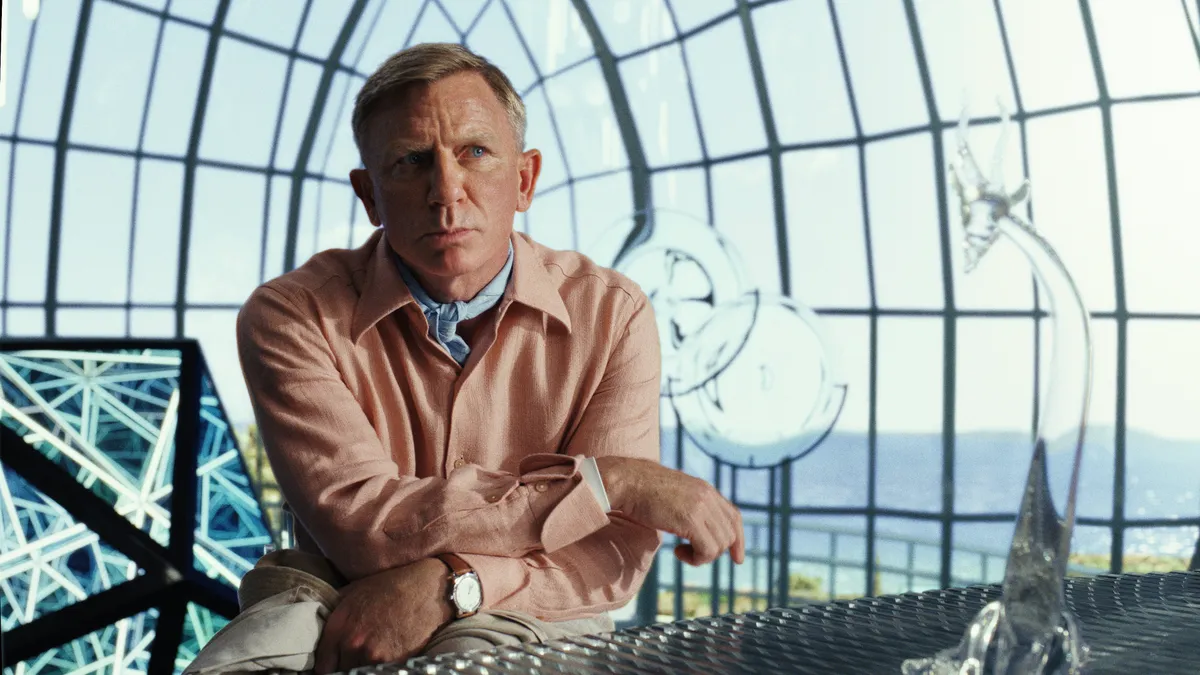The Knives Out sequel Glass Onion has finished its limited run in theaters and is coming to Netflix on December 23. The movie is just as good as everyone says it is, and one moment in particular had me literally squirming in my seat. It was deeply upsetting—in a very good way.
Warning: major spoilers ahead!
The plot of Glass Onion centers on billionaire Miles Brown (Edward Norton), who brings a group of old friends to his private island to play a murder mystery game. Like most billionaires, Miles is obsessed with showing off his extreme wealth, and his guests find out that he’s rented the Mona Lisa from the Louvre, which is closed to the public because of Covid.
Miles’s latest venture is a hydrogen-based energy source called Klear. Klear is too dangerous and unstable to release to the public, but Miles is doing it anyway, and he’s managed to coerce everyone into staking their own careers on it. In the film’s climax, Helen Brand (Janelle Monáe) realizes she can ruin Miles and avenge the death of her sister Cassandra if she uses a sample of Klear to blow up Miles’s home. As everything’s burning around them, Helen opens the protective casing around the Mona Lisa and consigns it to the flames.
And my god, that moment felt so real as I watched the film. It was almost physically painful to see the paint blistering and the canvas curling as the painting burned. But why, though? Why was it so awful to see an inanimate object get destroyed, especially when I knew that the real one was perfectly fine?
Why we love the Mona Lisa

The Mona Lisa isn’t just an expensive object. It’s beloved because Leonardo da Vinci was really, really good at what he did, and the genius of the Mona Lisa can’t be replicated. Viewing it is an intriguing experience because of the subject’s “imperfections”—it’s been speculated that Lisa Gherardini, who sat for the portrait, suffered from hypothyroidism—and the depth of personality behind her smile. We feel nothing when Helen breaks the glass sculptures in Miles’s home, but when the Mona Lisa burns, we feel like a friend is dying.
But that’s not the only reason it’s squirm-inducing. Although Miles is the worst person in the room, Helen is the one who pushes the button to expose the painting to the fire. That means that she, not Miles, is the one responsible for its destruction. Does that make her the villain?
Why does Helen destroy the Mona Lisa in Glass Onion?
I’m reminded, here, of the activists who threw tomato soup at Vincent Van Gogh’s Sunflowers as a protest against climate change. The painting was fine, but the action was shocking, and afterwards the activists released a statement about why they’d done it. “What is worth more,” they asked, “art or life? Is it worth more than food? Worth more than justice? Are you more concerned about the protection of a painting or the protection of our planet and people?”
And that’s the issue that complicates Helen’s motives. Yes, she’s avenging Cassandra and getting back at Miles (while ironically giving him the notoriety he’s always wanted). But by proving that Klear is too dangerous to use, she’s also potentially saving countless people from fiery, Hindenberg-esque deaths. Just blowing up the glass onion might have gotten her there, but using Klear to destroy one of the most beloved works of art in the world? That will ensure that no one ever trusts Miles and his schemes again.
The best stories challenge us in ways that can be pretty uncomfortable in the moment. The scene in which the Mona Lisa burns isn’t just shocking—it’s deeply thought provoking, and like Miles’s legacy, it won’t soon be forgotten.
(featured image: Netflix)










Published: Nov 30, 2022 01:43 pm